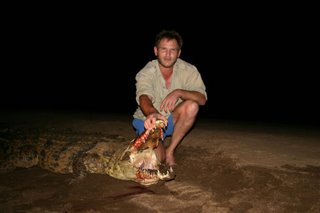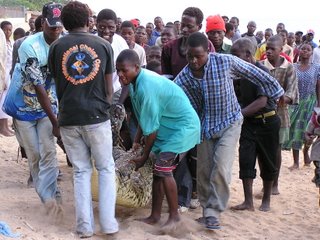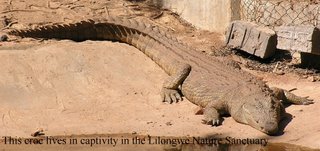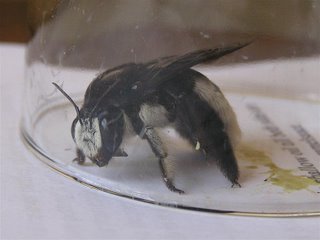I've been promising to post the croc hunting episodes for months now. Herewith Episode #2 -- AKA: The Last Malawi Dispatch. This was written and sent to the newsletter distribution list in February 2005 from Lilongwe, Malawi.
Given my imminent departure from Malawi, this past weekend was probably the last that I will enjoy in Senga Bay for quite some time. It is therefore unfortunate that the lodge we camped at was, for most intents and purposes closed, the owner away enjoying the comforts of another country and beach. Despite her absence, it was no trouble at all to secure her permission before she left to use her facilities due to our own cordial friendship with her and the fact that one of our companions for the weekend is a member of the family from whom she rents the premises of her lakeshore lodge.
It was a highly successful weekend of crocodile hunting and good companionship. That being said, there are two crocodiles of significant size and weight who are no longer in a position to either agree or disagree with that statement. Friday afternoon we were at the lodge and set up our tents and kitchen for a quick but hearty meal well before sundown. The three hunters were pleased to get out on the lake in good time to make it to their intended hunting grounds before dark. They would again use the nighttime spotlight technique described in my earlier dispatch on croc hunting. This time both the calm lake and lack of moon were in the hunters’ favour. However, due to my fairly advanced pregnancy, I elected to remain in camp. At just over five months along, I am not willing to forgo regular rest for the sake of going out and participating in the killing of (albeit man-eating) beasts.
It was well past midnight when the shadow of my partner’s form looming over the tent woke me before he could proudly say: are you coming to see my croc? When I got to the beach, I found the hunters manhandling the carcass of a 10foot croc out of the semi-inflatable boat. This was followed by a quick session of post-kill photos with the hunters and the body. Everyone was very chuffed, even the camp watchmen summoned from their own rest, didn’t seem too unhappy to participate in the heavy work. In order to move the beast from the shore to a suitable place on the lodge grounds away from prying eyes, it was loaded into a wheelbarrow. This exercise required the efforts of about five men. The hunters then sat down to a midnight toast and snack.
As the hunters relived the excitement of their hunt, I learned that the crocodile was discovered lurking around some fishermen’s nets. In doing so it was directly competing with the fishermen by collecting whatever fish the nets caught. The locale was not far from a village and, given its size, it may not have preyed on adult people but certainly could have taken children and smaller livestock. The wound from the single bullet that killed the beast went straight through it’s head and probably killed it instantly. As the hunters worked together to retrieve the body from the reeds where it was caught the beast exhibited the post-death reflex movement for which crocodiles are known. The thrashing of the dead beast’s tail was enough to unbalance and throw off the grip of the big men as they struggled to bring the carcass aboard the boat.

The next day, we all watched the fascinating process of skinning, marveling at the construction of the croc’s evil looking claws and the knife-edge sharpness of the ridges on its tail. This was indeed a monster. As explained in my earlier dispatch, it is the belly skin of the crocodile that is a commercially viable product. The rough, yet beautiful scales and ridges of the back are not as immediately useful in the construction of wallets, handbags and shoes. However, as one of the hunters and I took pictures of the topography of the crocodile, some interesting thoughts on display for aesthetic and educational purposes came to mind.

Given that the three men who were engaged to skin the beast had never skinned a croc before, it took them the better part of half a day to accomplish their task. They did so with skill and patience. The skin was in excellent condition both before and after the croc was finished wearing it. They expertly salted and rolled the belly skin for drying and did the same for the skin from the back. They also removed the head and de-fleshed the bones thereof in order for the jaw to become part of the souvenirs of the hunt. This was not the first crocodile that Kobus has shot and killed but the previous one had sunk away into the lake before he could retrieve the body.
Usually, African villagers will come from far to partake in the flesh of a game animal that has been hunted and killed. News of a kill (or anything else) travels fast. It is traditional for hunters to surrender the carcass to the locals once they have taken what they wish from it. However, in the case of crocodile in Malawi, the meat can unfortunately not be shared without danger to the hunters of being blamed for poisonings or worse. This is due to the traditional belief in “muti” or “mankwala.” Both of these are terms used for “medicine” rituals and potions and in this case the less than altruistic aspect of these traditional and still widely used practices. Crocodile spleen is considered very powerful and may very well be extremely poisonous. Not only would we be blamed for making this potent magic available but our party and our friend the lodge owner would quickly become targets for revenge should something awful occur. We could not let that happen. Therefore the skinners were carefully instructed not to open the internal cavities of the carcass at all and were not invited to take any of the flesh for their own consumption. The pinkish, naked body was left skinless and headless but otherwise perfectly intact and increasingly stinky on the lawn, ready to be disposed of in the lake, well away from the reach of any interested local sorcerers or traditional healers.
On Saturday evening, the men left again for a second night’s hunting as the sun was preparing to set. I sat reading a book, enjoying the chorus of local bird life before the inevitable blast of music from the local bar started up. With every word and beat clearly reaching me 500m away from the speakers, I could only imagine the eardrum shattering volume the men and women inside the bar compound were suffering. I found myself musing once again on the odd juxtapositions of the ancient with the modern in this place. I was surprised I slept at all but again, I woke shortly after midnight, this time to shouts and running. The howling of the wind and the roaring of the waves temporarily inured me to the realization that the music had stopped early for once. The lodge night watchmen were quickly gathering to join the three hunters in the effort to get the boat out of the water.
The wind was coming off the lake in a dry but steady blast, driving big, white-capped waves ashore and dashing our skipper’s boat dangerously against the beach with every pulse. His shouts above the roar of the weather quickly assured me that at least he was still well and in fine shape if a little frantic for the continued well being of his craft. The clear sky full of stars belied the sight of the angry water that would have made the trip back to camp rather uncomfortable if not downright dangerous. The waves and wind made it difficult to ascertain the condition of the other two hunters but eventually I could make out their forms as they strained to help drag the boat safely above the high water mark.
I completely missed seeing the shape of the dead crocodile on the beach between me and the crew around the boat until some time later. I did find the drenched gear that had been hastily piled on the beach and was busy carrying what I could back to the safety and shelter of the camp, starting with the camera and guns. With each trip, the strange smell first encountered on the beach became more overwhelming. By the time I was on my third or fourth tour the men had joined the effort and the snatches of conversation and stray comments caught over the roar of the lake and the wind provided an ever more detailed picture of their discomforts on the trip back to camp.
Having shot the beast up a river that feeds into the lake, they landed it on the shore to take some pictures. Kobus was again the man of the hour having done the deed himself. For the record: he shot his weapon three times over the entire weekend to dispatch the two beasts.

It was apparently a good half hour after all signs of the croc’s life and post-mortem reflex movement had ceased when they heaved the carcass into the boat. It was at that point that the former monster’s bowels decided to empty. At first only the boat’s skipper was really suffering as the mess was confined to the bow of the boat where water tends to collect and where he also stands to drive. A close encounter with a sandbar sent all the water and muck flying forward. This event combined with the small craft’s struggle through the four foot swells they encountered once they left the river and re-entered the lake quickly covered all three men and most of the gear in greasy, clingy stink. Leaving the carcass and the boat on the beach to wait for morning, they all hurried off to shower before toasting their good fortune at making it back to camp safely in such hair-raising and stinky circumstances.
Given my longer rest, I was the first to rise at 6am. I found the croc and the boat completely surrounded by curious people and a young man holding forth on crocodile misinformation and scare-tactics. The lodge watchman who had wisely sat himself in the boat was watching this beach-boy cum field guide and shaking his head. I approached with my camera and the leader of the mob bravely held the beast’s mouth open for a picture and then grabbed a wildly protesting small child and tried to put him on the ridged back to pose for another. The crowd gathered quickly and the braver men and children pushed and shoved each other for a chance to touch and feel the skin. One can safely assume that each and every one of them has lost someone close to them to witnessed or assumed crocodile attack. This was probably the first time that many of them could say that came that close to one without any harm to themselves.
While I was still standing among them, I discouraged a coordinated effort to flip the beast over to expose its less rugged belly skin. This was when I decided that the hunters needed to be woken to coordinate the shifting of beast’s resting place from the beach to the relative privacy of the lodge lawn. This move was effected as some real efforts at pulling legs away from the carcass and long sticks were in evidence among the crowd. I do not imagine that left to their own devices, the crowd would have been long in tearing the beast apart.

Of course, now it was general knowledge that we had a crocodile body in the lodge premises. The watchmen and skinners were constantly answering persistent knocks at the gate by people begging, pleading and demanding to view the spectacle. The beach boy cum croc mis-informant was particularly aggressive but, to his great disappointment, unsuccessful regarding his continuing involvement in the proceedings.
After a cooling rain shower and a thorough scrubbing of both boat and gear, the second carcass quickly joined the first in skinless and headless-ness. Later in the afternoon, both carcasses were unceremoniously dragged back to the water’s edge via Landrover. They again attracted lots of interest and attention despite their gag-inducing odors. As before, standing amongst the crowd, I heard that “mankwala” was a frequently muttered word. The people watched with interest, the more aggressive questioning and resisting the request to stand well away from the bodies as the hunters proceeded with the grisly task of launching the boat, dragging the crocs into the water and tying their tow ropes to the back of the boat while it bucked in the still strong waves. They motored away slowly towing the crocs behind them, out of sight, presumably to the far side of a close island. There they could find some rocks to tie to the carcasses to sink them back into the lake that spawned them. Their rotten and offal smells lingered in the grass where they were skinned and over the path where they were dragged back to the lake. The lodge owner’s dogs will have an interesting time sorting out what happened in their yard while they were away. Hopefully, in the interests of our continued welcome at the lodge, enough rain between now and their return will obscure any and all offending odors that could be detected via human olfactory capabilities.
Local interest in the crocs also lingered. It was some time after the men had motored away when I sent a man to answer yet more knocking at the gate. He returned with the story that it was “someone wanting to see the dinosaur.” Brilliant. One of the skinners later reported that a local medicine man had indeed offered him a significant amount of cash for “parts from inside” the body. Thankfully, our loyal skinner was not persuaded by the bribe. I explained that the method behind our apparent madness at sinking so much meat back into the lake was to avoid just that. It must be said that even the skinners were divided on whether or not the crocs would have made good eating. Every Malawian I have spoken to about crocs is convinced that one crocodile spleen in the wrong hands could be used to poison entire villages. When it comes to mankwala, even the most educated respects and even fears the power of the traditional healer. The skinners were well rewarded for their weekend’s work and all of them will get prints of the pictures I took of them at their work – they told me that their families will not believe the unlikely story that they were put to skinning crocs without photographic evidence.
So there you have it. A final Malawi dispatch. While my recent neglect of this newsletter project does not connote a complete lack of adventure or interesting events in my life, I am glad to leave you with such an unusual tale.


 Such breathtaking views. 7adults and 8kids, the later are so spoiled from living beside the Indian Ocean that most of the grown ups completely tuned out their various complains of hunger, thirst, missing shoes, refusing to wear hats and we eventually all fell silent soaking it all in. It takes about 40minutes to get there.
Dhow sailing boats have been in these waters for at least a millennium and a half if not two. These two were “modernized” by the addition of a relatively small outboard motor but were otherwise traditionally built with all wood pulleys and fixtures. If we weren’t perched on the gunwales, we were sprawled on the tarp covering the fishing nets that were stowed in the bottom of the boats. We were promised that on one way they would hoist the sail which is a marvelous thing to experience. They didn’t in our boat this time but they did in the other on the way home.
These dhows were hired for us by the handyman and long term resident of the property where we now live. They came from the fishing village just up the coast. If I get to see them again, I will ask the crews how old the boats are and how they came by them. It could very well be that they have been handed down through generations. Their price for the day was more than reasonable, they knew and handled their boats as extensions of their own bodies and they were helpful and cheerful through challenging children and authorities.
DH has decided that next time he wants to go at night and have a bonfire party. I don’t know how he’s going to allow for the windiness of the place or the navigational challenge of getting home in the dark. He’s going to have to discuss that with the dhow captains. Even if the later are keen to do it, I might not be brave enough to go along.
And here we are Monday. As I write, a sunbird plays in the water thrown up by a sprinkler into a hibiscus bush. I just tried to sneak around to get a picture but I startled him away. I can hear the whistles and chatter of the alien but resident parrots. They’ve become neighbourhood mascots after it is suspected they’ve been abandoned and/or released by former residents of the neighbourhood. These ones are African Greys but I also know of a Ring Necked Parrot that was lost here by former residents of the very house we now occupy. That was years ago but it is not implausible that Timothy could still be around.
Happy Monday all.
Such breathtaking views. 7adults and 8kids, the later are so spoiled from living beside the Indian Ocean that most of the grown ups completely tuned out their various complains of hunger, thirst, missing shoes, refusing to wear hats and we eventually all fell silent soaking it all in. It takes about 40minutes to get there.
Dhow sailing boats have been in these waters for at least a millennium and a half if not two. These two were “modernized” by the addition of a relatively small outboard motor but were otherwise traditionally built with all wood pulleys and fixtures. If we weren’t perched on the gunwales, we were sprawled on the tarp covering the fishing nets that were stowed in the bottom of the boats. We were promised that on one way they would hoist the sail which is a marvelous thing to experience. They didn’t in our boat this time but they did in the other on the way home.
These dhows were hired for us by the handyman and long term resident of the property where we now live. They came from the fishing village just up the coast. If I get to see them again, I will ask the crews how old the boats are and how they came by them. It could very well be that they have been handed down through generations. Their price for the day was more than reasonable, they knew and handled their boats as extensions of their own bodies and they were helpful and cheerful through challenging children and authorities.
DH has decided that next time he wants to go at night and have a bonfire party. I don’t know how he’s going to allow for the windiness of the place or the navigational challenge of getting home in the dark. He’s going to have to discuss that with the dhow captains. Even if the later are keen to do it, I might not be brave enough to go along.
And here we are Monday. As I write, a sunbird plays in the water thrown up by a sprinkler into a hibiscus bush. I just tried to sneak around to get a picture but I startled him away. I can hear the whistles and chatter of the alien but resident parrots. They’ve become neighbourhood mascots after it is suspected they’ve been abandoned and/or released by former residents of the neighbourhood. These ones are African Greys but I also know of a Ring Necked Parrot that was lost here by former residents of the very house we now occupy. That was years ago but it is not implausible that Timothy could still be around.
Happy Monday all.































